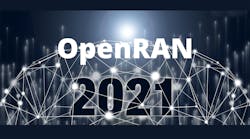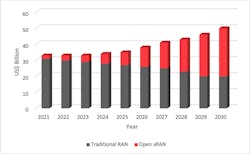>> Electronic Design Resources
.. >> Digital Editions
.. .. >> Top Stories of the Week
.. .. .. >> 2021 Electronic Design Forecasts
This article appeared in Microwaves & RF and has been published here with permission.
What you’ll learn:
- What is OpenRAN?
- What agencies are promoting O-RAN adoption?
- Benetel’s role in the O-RAN ecosystem.
The arrival of 5G promises to transform our daily lives, with its superior network performance enabling a wide range of innovative applications across all industrial sectors. However, the rollout of this revolutionary wireless technology isn’t without its challenges, as the world’s mobile network operators (MNOs) struggle to adapt their business models and operations to meet the needs of multiple new markets.
In particular, the traditional, vertically oriented, MNO supply chain is unable to flex sufficiently to create the innovative new services that will drive 5G revenues. The current geopolitical situation is adding even more complexity, as global security concerns threaten to leave MNOs dependent on a shrinking number of large global suppliers.
Faced with this threat to the economic success of 5G, governments and industry have recognized that opening the Radio Access Network (RAN) is critical to removing this roadblock. By disaggregating the core elements of the RAN and specifying open, standard interfaces, an open RAN will encourage new market entrants, generating disruption with the attendant benefits of innovation and reduced total cost of ownership.
In the UK, for example, the government recently published its 5G Supply Chain Diversification Strategy, which has three core strands:
- Supporting incumbent suppliers.
- Attracting new suppliers into the UK market.
- Accelerating the development and deployment of open-interface solutions.
The U.S. government is equally focused on supporting an open RAN, with a recent bill proposing to inject $750 million over the next 10 years to promote the accelerated development and deployment of open-RAN technologies.
As other governments around the world consider their positions, the markets agree that OpenRAN will be a key element in future networks. ABI Research, a market-intelligence organization, forecasts OpenRAN spending by public cellular networks to reach $10 billion globally by 2026-27 and to exceed traditional RAN spending by 2030 at $30 billion (Fig. 1). ABI also expects OpenRAN spending on enterprise, industrial, and private networks to generate a further $10 billion in 2030.
What is OpenRAN?
RAN architectures have evolved considerably in recent years as first LTE and now 5G networks are rolled out. In centralized RAN (C-RAN) configurations, the baseband unit (BBU) functionality is centralized along with some of the upper layers of the remote radio unit (RRU). This allows for a configuration where one centralized unit (CU) serves multiple radio units (RUs), enabling operators to reduce costs such as site rental and power. This separation of RAN functionality is standardized in 3GPP Release 15, where a higher-layer split is specified with a well-defined interface (F1) between two logical units: the centralized unit (CU) and the distributed unit (DU).
Virtualization of the RAN (vRAN) takes the concept one stage further, with the ultimate aim of enabling software-defined, virtualized network functions to run on commercial, off-the-shelf computer hardware. By separating the network functions in this way, RAN functions from multiple vendors would be able to run on the same hardware, increasing flexibility for the MNO and further reducing total cost of ownership (TCO). Ultimately, a fully virtualized RAN will pave the way to cloud-level economies by leveraging standard components for common tasks, avoiding lock-in from vendor-specific solutions.
Although several vRAN implementations exist today, many of them are built on closed, proprietary interfaces. To achieve the level of supply-chain diversity required to stimulate 5G growth, an open RAN environment is required (Fig. 2). In such an environment, standards are defined for all key interfaces within the RAN environment, transforming this vertically integrated market into a horizontally oriented version with lowered barriers to entry, enabling a range of new vendors to develop innovative new products.
Recent developments in OpenRAN technology and associated work on interoperability and standards development by key industry bodies have propelled a move away from proprietary networks within the telecommunication industry. The web-services model in the computer industry illustrates the economies of scale that may be achievable by opening the RAN, and this opportunity is driving a significant shift in attitude among the industry’s main players.
Where is OpenRAN Today?
2020 was a pivotal year for OpenRAN, as the concept gained credibility and momentum in a previously skeptical marketplace. The O-RAN Alliance, one of three key industry bodies driving the adoption of OpenRAN, marked its second year of operation by signing KDDI, Rakuten, and Vodafone to its board while, at the same time, continuing to work on the development of specifications for disaggregated RAN deployments.
The other two influential industry organizations, Telecom Infra Project (TIP) and the Open Networking Foundation (ONF), were joined by the newly launched Open RAN Policy Coalition that has a membership covering operators, equipment manufacturers, and silicon fabricators, with a goal of advocating government policies aimed at driving OpenRAN adoption. These bodies have successfully worked together to create the conditions required to stimulate the emergence of a thriving OpenRAN supplier ecosystem.
More significantly, 2020 saw the first public commitments to OpenRAN by the world’s MNO community. In the U.K., Vodafone announced a 2,600-site OpenRAN deployment with a commitment to have 1,150 of these sites live by 2023. At the same time, Telefonica unveiled plans to begin OpenRAN trials in its core markets of Germany, Spain, the U.K., and Brazil. Furthermore, the Iberian-based operator intends to invest up to 50% of its RAN capital-expenditure budget in O-RAN technologies between 2022 and 2025.
In Germany, Deutsche Telekom, an avid supporter of O-RAN, revealed plans for a targeted deployment in Neubrandenburg, a town near Berlin with a population of 65,000. Elsewhere, in Japan, Rakuten, a new entrant among mobile operators, aims to cover more than 80% of the country’s population by 2021 with its brand-new network built entirely on O-RAN technology. The operator has stated its intentions to pass considerable savings, based on its open-architecture, multi-vendor environment, on to its customers in the form of reduced prices.
What’s Next—2021 and Beyond
2021 is likely to see OpenRAN gain more momentum, as the deployments announced in 2020 begin to roll out and others are announced.
In the U.S., wireless newcomer Dish will begin roll out of the world’s second (after Rakuten) large, greenfield network based entirely on O-RAN technology. With a commitment to cover 70% of the U.S. population by June 2023, this new network will be a further test of O-RAN’s carrier-grade capabilities—and is bound to highlight further areas for development. More trials and deployments are likely to be announced during 2021 with both Orange and the U.K.’s O2 seeing a role for OpenRAN in indoor coverage for business customers.
Based on this increasing level of trial and deployment activity, membership of the key industry bodies is likely to swell, further enriching the industry dialogue. In turn, it will lead to an acceleration of standards development and interoperability testing. The TIP, for example, has already published its readiness plan for 2021, and further blueprints and roadmaps are anticipated this year as the deployments continue. By the end of the year, OpenRAN can be expected to be firmly embedded in the deployment plans of most mainstream operators and gain a significant foothold in enterprise and private network deployments.
This gathering momentum will encourage more players to join the O-RAN ecosystem, including systems integrators such as Marvenir. It also will provide more growth opportunities for existing quality players such as Dublin’s Benetel.
For its part, since its foundation in 2001, Benetel has been a pioneer in RAN and small-cell development, amassing a wealth of expertise when responding to increases in demand for coverage density with each successive mobile generation. Such expertise positions Benetel as a strong player in the emerging OpenRAN ecosystem, both as a member of O-RAN, OpenAirInterface, and TIP, and as a manufacturer of OpenRAN products. One example product is the RAN550 (Fig. 3), the latest in a family of O-RAN-compliant indoor 5G radio units aimed at enterprise and private networks. Meanwhile, work is underway in collaboration with leading semiconductor companies on a ground-breaking massive MIMO design.
Benetel also is an active advocate of a strong 5G research and development community, with products such as the RAN100 O-RU oriented toward the design lab. It allows for experimentation with ORAN-based network infrastructure, particularly in relation to providing superior indoor cellular coverage. Benetel’s strategy of enabling innovation in the RAN is also demonstrated through its 5G NR Non-Standalone (NSA) Evaluation System, an indoor evaluation platform targeted for laboratory, research, and test integration purposes.
Conclusion
2021 will be a critical year for O-RAN as laboratory experiments and field trials give way to commercial deployments. With full-scale, greenfield network builds underway in Japan and the U.S., and smaller scale deployments planned in Europe, the proportion of O-RAN technology in the network is set to expand rapidly.
This expansion depends on the continued growth of a healthy ecosystem, bringing new suppliers and innovation to this developing market. Players in this ecosystem will comprise both new entrants bringing new skills and technologies as well as existing industry experts such as Benetel, which has a product line and strategy aligned with the support of this new RAN technology.



